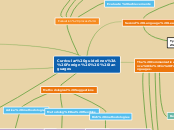Curricular guidelines: Foreign languages
Second Language Learning
The Communicative Competence
in Foreign Languages.
Elements and Approaches of the Curriculum of Foreign Languages
Hypothesis and as a modela that make stronger the langauge development.
New technologies in the foreign language curriculum.
Globalization and technological capacities for learning in the information age
AREAS OF DEVELOPMENT AND ACHIEVEMENT INDICATORS
Students must acquire familiarity with cultures that use the foreign language and generate awareness of how language and culture interact
Interlingual
It is the process of an apprentice to speak a second language.
Stage
Silent period
Use of common words and phrases
Pre-syntactic stadium
The structures are taken into account
in the sentences (S + V + C)
Syntactic period
Prepositions, past forms and interrogation are used.
Intercultural
Interaction between different cultures
Internal factor
knowledge
External factor:
Interaction between languages
and cultures.
Types of language
competence
Organizational competence
Domain of the formal structure of language.
Competencia Pragmática
Proper knowledge of the language.
Learning strategies
strategies
Direct strategies:
Memory strategies
Cognitive strategies
Compensation strategies
Indirect strategies:
Social strategies
Affective strategies
Metacognitive strategies
